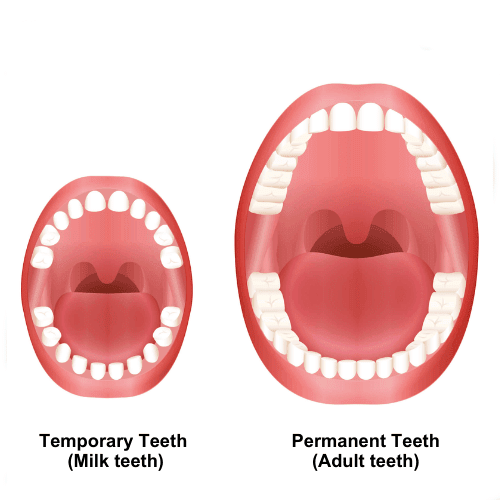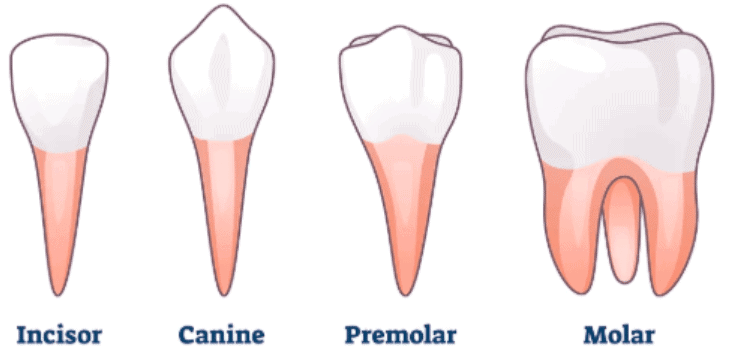Teeth and Digestive System Chapter Notes | Science for Class 4 PDF Download
| Table of contents |

|
| Introduction |

|
| Sets of Teeth |

|
| Different Types of Teeth and Their Functions |

|
| Parts of a Tooth |

|
| Ways to Protect Our Teeth |

|
| Digestive System |

|
Introduction
Teeth are located in our mouth on both the upper and lower jaws.
Sets of Teeth
Humans have two sets of teeth: temporary teeth and permanent teeth.
- When a baby is born, they do not have any teeth. By the time a child is about two and a half years old, they typically have twenty teeth. This first set of teeth is called temporary teeth or milk teeth.
- Temporary teeth start to fall out when a child is around six years old. As these teeth fall out, new ones grow in their place, and these new teeth are larger than the milk teeth.
- The set of teeth that replaces the milk teeth is called permanent teeth. An adult usually has thirty-two permanent teeth, with sixteen in the upper jaw and sixteen in the lower jaw.

Different Types of Teeth and Their Functions
Our teeth come in various shapes and sizes, and they play different roles in the process of eating. There are four main types of teeth, each designed for specific functions:
- Incisors. These are the sharp, flat teeth located at the front of each jaw. Incisors are used for cutting and biting into food. There are a total of eight incisors, with four in each jaw.
- Canines. Found on either side of the incisors, canines are sharp and pointed teeth. They are used for tearing food. There are four canines in total, two in each jaw.
- Premolars. These teeth are flat and broad, situated next to the canines. Premolars are used for crushing and chewing food. There are eight premolars in total, four in each jaw.
- Molars. Located at the back of each jaw, molars are flat and broad teeth, larger than premolars. They are essential for chewing and grinding food thoroughly. There are twelve molars in total, six in each jaw.

Parts of a Tooth
A tooth consists of two main parts: the crown and the root. The crown is the visible part of the tooth that protrudes above the gum line, while the root is embedded within the gum tissue. The outermost layer of a tooth is called the enamel, which is the hardest substance in the human body. Beneath the enamel lies the dentine, which is also hard but not as tough as enamel. Inside the dentine is the soft pulp, which makes up the central part of the tooth. The pulp contains blood vessels and nerves.
Taking Care of Our Teeth
- Teeth play a crucial role in cutting, tearing, and chewing food. When we eat, food particles often get stuck in the gaps between our teeth. It is important to remove these food particles because if teeth are not cleaned properly, germs can thrive on them and form a yellow sticky layer known as plaque.
- These germs convert the sugar present in food particles into acid. This acid attacks the enamel, leading to the formation of a cavity. When the cavity reaches the pulp, it causes pain in the tooth. Tooth decay can result in bad breath, toothache, and indigestion.
Ways to Protect Our Teeth
- Brush your teeth regularly: Brush your teeth twice a day, once in the morning and once at night. Make sure to clean both the inner and outer surfaces of your teeth properly. When brushing, remember to brush the upper teeth downwards and the lower teeth upwards. Don't forget to brush the chewing surface of your premolars and molars as well.
- Rinse your mouth after meals: Rinse your mouth with water after every meal to remove food particles that may get stuck between your teeth.
- Limit sugary and sticky foods: Try to avoid eating too many chocolates, sweets, and sticky foods, as these can stick to your teeth and cause decay.
- Eat healthy foods: Include fruits and raw vegetables like carrots and radishes in your diet, and make sure to drink milk every day for strong and healthy teeth.
- Visit the dentist regularly: It's important to visit your dentist every six months for regular check-ups and cleanings.
Digestive System
The food we consume daily is diverse and needs to be broken down into simpler forms for our bodies to absorb the necessary nutrients. This process of breaking down food is known as digestion, and it involves the coordinated effort of various organs that make up the digestive system.
Digestion involves several organs, each playing a crucial role in breaking down food and absorbing nutrients. Let's go through the process step by step:
- Mouth: The journey of digestion begins in the mouth, where teeth chew and grind the food into smaller pieces. During this process, saliva, a digestive liquid, mixes with the food, making it soft, moist, and easier to digest.
- Oesophagus (Food Pipe): After chewing, the food travels down the food pipe (oesophagus) and reaches the stomach.
- Stomach: The stomach is a sac-like organ where digestive juices further break down the food.
- Small Intestine: From the stomach, the food passes into the small intestine, where digestive juices complete the digestion process. The walls of the small intestine absorb useful nutrients from the digested food into the bloodstream. The blood then carries these nutrients to various parts of the body.
- Large Intestine: Any food that remains undigested in the small intestine enters the large intestine. Here, water is absorbed from the undigested food, and the remaining waste is formed into faeces.
- Liver: The liver produces bile, a digestive juice that aids in the digestion of food. Bile is released into the small intestine to assist in this process.
- Anus: Finally, faeces are expelled from the body through the anus.
Healthy Eating Habits
- Always chew your food well.
- Eat a balanced diet to maintain good health.
- Include fruits and vegetables in your daily meals.
- Drink plenty of water throughout the day.
- Remember to wash your hands before and after eating.
|
49 videos|156 docs|34 tests
|
FAQs on Teeth and Digestive System Chapter Notes - Science for Class 4
| 1. What are the different types of teeth and their functions? |  |
| 2. What are the main parts of a tooth? |  |
| 3. How can we protect our teeth effectively? |  |
| 4. What role do teeth play in the digestive system? |  |
| 5. Why is it important to take care of our teeth? |  |















